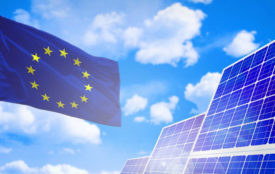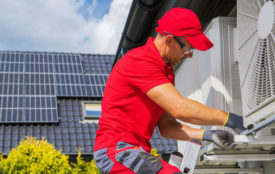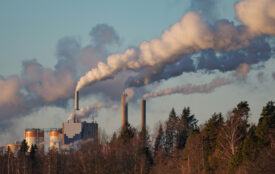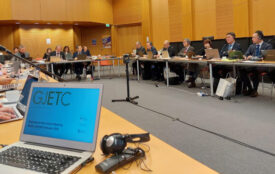Germany is able to become a (nearly) greenhouse gas-neutral country
Large industrialized countries can also reduce CO2 emissions by 95 percent until 2050.
Can an industrialized country such as Germany avoid nearly all of its man-made greenhouse gas emissions? According to a study by the Federal Environment Agency, the answer is ‘yes’: “It is technically possible to reduce greenhouse gas emissions by nearly 100 per cent compared to 1990 levels – with technologies that are available today,” says Jochen Flasbarth, President of the Federal Environment Agency (UBA).
“Our current annual per capita emissions of 10 tonnes CO2 equivalents can be brought down to less than one tonne per capita in 2050. Compared to international reference year 1990, that represents a reduction of 95%. Germany can become virtually greenhouse gas-neutral by the middle of the century,” said UBA’s President upon the publication of the UBA study “Greenhouse gas-neutral Germany 2050”. To achieve true greenhouse gas neutrality, emissions in other countries would also have to be reduced – beyond their respective climate change commitments – to offset the remaining tonne per capita.
“Energy is the decisive sector to set the right course for climate protection,” said Flasbarth. He continued, “Electricity, heat and conventional fuels now account for about 80 per cent of our greenhouse gas emissions. But we can reduce our final energy consumption in 2050 by half compared to 2010, and we can cover our demand entirely with renewable sources of energy. We can already prevent more than three-quarters of emissions, and that requires neither nuclear power nor underground CO2 sequestration.”
Reducing greenhouse gas emissions by 95 per cent is only possible if all sectors do their bit. In addition to the energy sector (including transport), efforts must be made by industry, waste and wastewater management as well as agriculture and forestry. Since emissions from agriculture and certain industrial processes cannot be avoided completely, the essence of the UBA scenario is an energy supply based on renewables only – and that includes power supply, heating and fuel supply in Germany. The UBA is banking on wind and solar energy in particular for 2050. In contrast, it sees no future in cultivated biomass. “Instead of growing crops like maize and rape for the sole purpose of energy production, we favour the use of biomass from waste and residual wastes as these materials do not compete with food production,” said Mr Flasbarth.
The essential component in the transition to a society that is almost completely greenhouse gas-neutral is to convert the power which will be produced entirely from renewables into hydrogen, methane and long-chain hydrocarbons. Solar and wind power are used in what is known as ‘power-to-gas’ and ‘power-to-liquid’ processes to produce methane or other liquid fuels through the electrolysis of water or other catalytic processes. These fuels can be used to replace natural gas or diesel and petrol in the transport sector, as fuels for heating systems, or as raw materials in the chemical industry. A few pilot projects in Germany have already implemented this technology successfully.
The transport sector currently accounts for a share of about 20 per cent of total greenhouse gas emissions. These emissions can be reduced to zero by 2050 on the key condition that unnecessary transport is avoided. Unavoidable transport must be shifted to environmentally friendly modes of transport such as bicycle, bus or rail. The technical efficiency of passenger cars and heavy goods vehicles must be further improved. The most important factor, however, is the switch to renewable energy. Mr Flasbarth says, “In the UBA scenario, passenger cars operate about 60 per cent on electricity in 2050. Aeroplanes, ships and heavy goods vehicles will continue to rely mainly on liquid fuels, except that these fuels will be synthetic, climate-friendly and produced in power-to-liquid processes”.
Demand for space heating and process heat for industry in 2050 could be met by renewable power and methane generated from renewable sources. This would result in a zero level of energy-related greenhouse gas emissions. Process- and raw material-driven greenhouse gas emissions decrease by 75 per cent, to about 14 million tonnes, but would require the chemical industry to shift from its present petroleum-based raw material supply to hydrocarbons generated from renewable energy. As a result, there would be virtually no emissions from the production of ammonia or other chemical syntheses.
Emissions in the waste and wastewater sectors have been reduced dramatically up to now. In 2050 levels could potentially be a mere three million tonnes. To achieve this, even more landfill gas must be collected and used in cogeneration plants. In addition, improving the ventilation of biowaste composting plants could more effectively help to prevent the release of climate-damaging methane.
The largest emitter in 2050 will be agriculture, with emissions that are still 35 million tonnes CO2 equivalents. Because technical measures alone are inadequate to achieve the targeted reduction, livestock populations in general, and of ruminants in particular, must be lowered.
The Federal Environment Agency based its scenarios on the assumption that Germany will continue to be a leader among industrialized countries in 2050. Furthermore, it also assumed that the population’s consumer behaviour will not undergo fundamental change. More climate- and environmentally friendly lifestyles would of course facilitate the achievement of climate protection goals.
The challenge of achieving a 95-per cent reduction of greenhouse gases is derived from scientific research results. These results also led to the international agreement to limit the increase in global mean temperature to a maximum of 2 degrees. Global emissions of greenhouse gases must therefore be reduced by 50 per cent until the middle of the century; for the industrialized countries, that means cutting emissions by 80-95% compared to 1990 levels. Germany and the EU have set their climate protection goals correspondingly.








